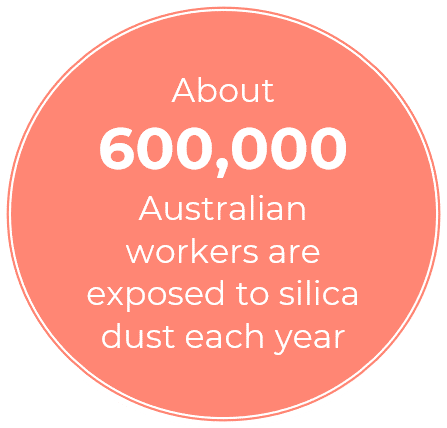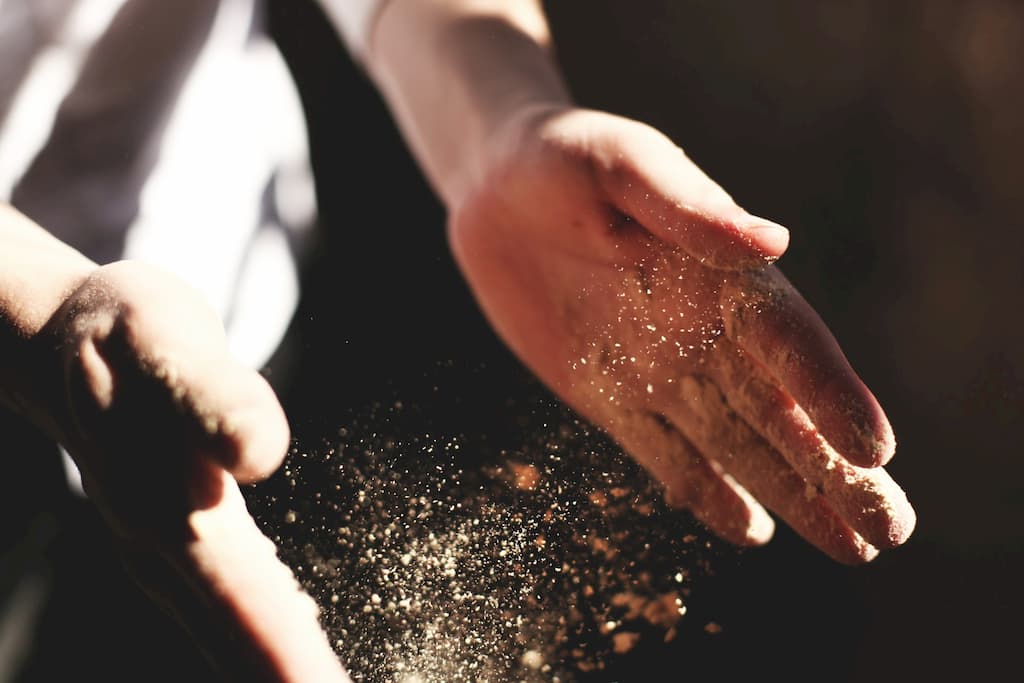KEY TAKEOUTS:
1. Silica dust is a natural mineral found in some stone, rock, sand, brick, tiles, concrete, gravel and clay. Exposure is caused by breaking, crushing or milling this type of material.
2. Silicosis occurs when crystalline silica dust scars the lungs. It's a serious and incurable disease, with symptoms including shortness of breath, coughing, fatigue and weight loss.
3. The occupations with the greatest exposure include: miners, construction workers, farmers and engineers.
4. Using local exhaust ventilation or wetting dust can reduce silica dust levels by 99%.
What is silica dust?
Crystalline silica is a natural mineral found in construction materials such as concrete, bricks, tiles, mortar and engineered stone. When these materials are worked on, silica dust is released. As its particles are 100 times smaller than ordinary sand, it poses a significant health hazard and could rival the impact of asbestos in the years to come.
Tasks & exposure
Approximately 600,000 Australian workers are exposed to silica dust in the workplace each year, and it’s been estimated that more than 10% of these will develop a form of lung cancer over the course of their life as a result of that exposure.
Examples of work activities that can generate respirable silica dust particles include:
- during fabrication & installation of composite (engineered or manufactured) stone countertops
- excavation, earth moving & drilling plant operations
- clay & stone processing machine operations
- paving and surfacing
- mining, quarrying & mineral ore treating processes
- tunnelling
- construction labouring activities
- brick, concrete or stone cutting; especially using dry methods
- abrasive blasting
- foundry casting
- angle grinding, jack hammering & chiselling of concrete or masonry
- hydraulic fracturing of gas & oil wells
- pottery making
THERE IS CURRENTLY NO AVAILABLE CURE FOR SILICOSIS. THE ONLY WAY TO STOP THE DISEASE IS VIA PREVENTION.
Health risks
- chronic bronchitis
- emphysema
- silicosis
- lung cancer
- kidney damage
- auto-immune disease
Silicosis occurs when crystalline silica dust scars the lungs. It's a serious and incurable disease, with symptoms including shortness of breath, coughing, fatigue and weight loss.
Exposure control
The good news is that there are some straightforward ways to protect you and your staff. In fact, research shows that simply using local exhaust ventilation or wetting dust to suppress it can reduce levels by 99 percent.
- Use on-tool dust extraction units
- Use on-tool water suppression units
- Separate employees from the dust source
- Use water respiratory protection
- Clean dusty floors with vacuum or wet methods
- Train employees on risks and effective control
Visit
safeworkaustralia for more information about silica dust and some of the legal responsibilities relating to protecting workers from developing silicosis.
DISCLAIMER:
This article is informational only and should not be construed as individual advice as it does not consider your individual needs. You should consider if the insurance is suitable for you and read the Product Disclosure Statement or policy Wording before buying insurance.
KEY TAKEOUTS:
1. Silica dust is a natural mineral found in some stone, rock, sand, brick, tiles, concrete, gravel and clay. Exposure is caused by breaking, crushing or milling this type of material.
2. Silicosis occurs when crystalline silica dust scars the lungs. It's a serious and incurable disease, with symptoms including shortness of breath, coughing, fatigue and weight loss.
3. The occupations with the greatest exposure include: miners, construction workers, farmers and engineers.
4. Using local exhaust ventilation or wetting dust can reduce silica dust levels by 99%.
What is silica dust?
Crystalline silica is a natural mineral found in construction materials such as concrete, bricks, tiles, mortar and engineered stone. When these materials are worked on, silica dust is released. As its particles are 100 times smaller than ordinary sand, it poses a significant health hazard and could rival the impact of asbestos in the years to come.
Tasks & exposure
Approximately 600,000 Australian workers are exposed to silica dust in the workplace each year, and it’s been estimated that more than 10% of these will develop a form of lung cancer over the course of their life as a result of that exposure.
Examples of work activities that can generate respirable silica dust particles include:
- during fabrication & installation of composite (engineered or manufactured) stone countertops
- excavation, earth moving & drilling plant operations
- clay & stone processing machine operations
- paving and surfacing
- mining, quarrying & mineral ore treating processes
- tunnelling
- construction labouring activities
- brick, concrete or stone cutting; especially using dry methods
- abrasive blasting
- foundry casting
- angle grinding, jack hammering & chiselling of concrete or masonry
- hydraulic fracturing of gas & oil wells
- pottery making
THERE IS CURRENTLY NO AVAILABLE CURE FOR SILICOSIS. THE ONLY WAY TO STOP THE DISEASE IS VIA PREVENTION.
Health risks
- chronic bronchitis
- emphysema
- silicosis
- lung cancer
- kidney damage
- auto-immune disease
Silicosis occurs when crystalline silica dust scars the lungs. It's a serious and incurable disease, with symptoms including shortness of breath, coughing, fatigue and weight loss.
Exposure control
The good news is that there are some straightforward ways to protect you and your staff. In fact, research shows that simply using local exhaust ventilation or wetting dust to suppress it can reduce levels by 99 percent.
- Use on-tool dust extraction units
- Use on-tool water suppression units
- Separate employees from the dust source
- Use water respiratory protection
- Clean dusty floors with vacuum or wet methods
- Train employees on risks and effective control
Visit
safeworkaustralia for more information about silica dust and some of the legal responsibilities relating to protecting workers from developing silicosis.
DISCLAIMER:
This article is informational only and should not be construed as individual advice as it does not consider your individual needs. You should consider if the insurance is suitable for you and read the Product Disclosure Statement or policy Wording before buying insurance.









